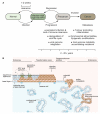The Not-So-Good, the Bad and the Ugly: HPV E5, E6 and E7 Oncoproteins in the Orchestration of Carcinogenesis
- PMID: 34696321
- PMCID: PMC8541208
- DOI: 10.3390/v13101892
The Not-So-Good, the Bad and the Ugly: HPV E5, E6 and E7 Oncoproteins in the Orchestration of Carcinogenesis
Abstract
Infection with HPV starts with the access of the viral particles to basal cells in the epidermis, potentially via microtraumas to the skin. The basal cells are able to keep away these pathogens in normal circumstances through a robust immune response from the host, as HPV infections are, in general, cleared within 2 to 3 weeks. However, the rare instances of persistent infection and/or in cases where the host immune system is compromised are major risk factors for the development of lesions potentially leading to malignancy. Evolutionarily, obligatory pathogens such as HPVs would not be expected to risk exposing the host to lethal cancer, as this would entail challenging their own life cycle, but infection with these viruses is highly correlated with cancer and malignancy-as in cancer of the cervix, which is almost always associated with these viruses. Despite this key associative cause and the availability of very effective vaccines against these viruses, therapeutic interventions against HPV-induced cancers are still a challenge, indicating the need for focused translational research. In this review, we will consider the key roles that the viral proteins play in driving the host cells to carcinogenesis, mainly focusing on events orchestrated by early proteins E5, E6 and E7-the not-so-good, the bad and the ugly-and discuss and summarize the major events that lead to these viruses mechanistically corrupting cellular homeostasis, giving rise to cancer and malignancy.
Keywords: E5; E6; E7; HPV; carcinogenesis; viral oncoproteins.
Conflict of interest statement
The authors declare no conflict of interest.
Figures





Similar articles
-
Hallmarks of HPV carcinogenesis: The role of E6, E7 and E5 oncoproteins in cellular malignancy.Biochim Biophys Acta Gene Regul Mech. 2019 Feb;1862(2):153-162. doi: 10.1016/j.bbagrm.2019.01.001. Epub 2019 Jan 29. Biochim Biophys Acta Gene Regul Mech. 2019. PMID: 30707946 Review.
-
What are the essential determinants of human papillomavirus carcinogenesis?mBio. 2024 Nov 13;15(11):e0046224. doi: 10.1128/mbio.00462-24. Epub 2024 Oct 4. mBio. 2024. PMID: 39365046 Free PMC article. Review.
-
The Autophagy Process in Cervical Carcinogenesis: Role of Non-Coding-RNAs, Molecular Mechanisms, and Therapeutic Targets.Cells. 2022 Apr 13;11(8):1323. doi: 10.3390/cells11081323. Cells. 2022. PMID: 35456001 Free PMC article. Review.
-
Carcinogenesis Associated with Human Papillomavirus Infection. Mechanisms and Potential for Immunotherapy.Biochemistry (Mosc). 2019 Jul;84(7):782-799. doi: 10.1134/S0006297919070095. Biochemistry (Mosc). 2019. PMID: 31509729 Review.
-
The Role of E6 Spliced Isoforms (E6*) in Human Papillomavirus-Induced Carcinogenesis.Viruses. 2018 Jan 18;10(1):45. doi: 10.3390/v10010045. Viruses. 2018. PMID: 29346309 Free PMC article. Review.
Cited by
-
Bioinformatics analysis of immune characteristics in tumors with alternative carcinogenesis pathways induced by human papillomaviruses.Virol J. 2023 Dec 4;20(1):287. doi: 10.1186/s12985-023-02241-6. Virol J. 2023. PMID: 38049810 Free PMC article.
-
HPV-Positive and -Negative Cervical Cancers Are Immunologically Distinct.J Clin Med. 2022 Aug 18;11(16):4825. doi: 10.3390/jcm11164825. J Clin Med. 2022. PMID: 36013065 Free PMC article.
-
Single domain antibodies from camelids in the treatment of microbial infections.Front Immunol. 2024 May 17;15:1334829. doi: 10.3389/fimmu.2024.1334829. eCollection 2024. Front Immunol. 2024. PMID: 38827746 Free PMC article. Review.
-
Understanding the HPV associated cancers: A comprehensive review.Mol Biol Rep. 2024 Jun 14;51(1):743. doi: 10.1007/s11033-024-09680-6. Mol Biol Rep. 2024. PMID: 38874682 Review.
-
Fibroblast stromal support model for predicting human papillomavirus-associated cancer drug responses.J Virol. 2024 Oct 22;98(10):e0102424. doi: 10.1128/jvi.01024-24. Epub 2024 Sep 13. J Virol. 2024. PMID: 39269177 Free PMC article.
References
-
- Hanahan D., Weinberg R.A. Holland—Frei Cancer Medicine. Wiley-Blackwell Publishers; Hoboken, NJ, USA: 2016. Biological Hallmarks of Cancer; pp. 1–10.
Publication types
MeSH terms
Substances
LinkOut - more resources
Full Text Sources
Research Materials

